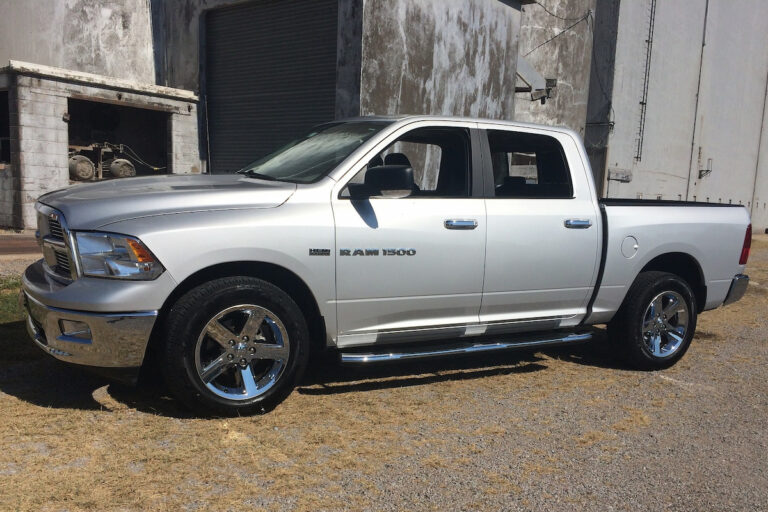Why Is Your Ram 1500 Payload So Low?
More often than not, people buy trucks for their towing and payload capacities.
Whether owners use their pickups for work or recreation, a truck is ideal for hauling large objects or materials without needing heavy-duty machinery.
Even so, potential truck buyers seem to believe the Ram 1500 has a low payload capacity.
In fact, Ram 1500s have fairly respectable payload capacities when compared to similarly-sized trucks. However, Ram’s payload and towing capabilities often fall short of consumer expectations because of their heavier curb weight and all-steel frames.
What is Payload Capacity?

Before discussing the payload capacity of a Ram 1500, it’s important to understand how payload is calculated.
A truck’s payload capacity is the maximum weight it can carry before the suspension breaks or the car no longer drives.
It’s calculated by taking the truck’s Gross Vehicle Weight Rating (GVWR) and subtracting its curb weight.
GVWR is the maximum weight a truck can hold before it gets damaged.
The body, frame, tires, and suspension are all tested to determine this weight limit.
A vehicle’s curb weight is its weight without anything in it, including you and any items in the truck bed or cab.
The only things factored into curb weight are the components of the truck and the fluids it needs to run.
It’s also important to note that payload capacity doesn’t just apply to items in the truck bed – the driver, the passengers, and any objects in the vehicle count against total capacity.
Why Are Ram 1500 Payloads So Low?
Ram 1500 payloads are limited by their 98% steel frames, which increase their curb weight.
In comparison, competitors like Ford recently switched to aluminum frames, making their trucks lighter and improving their payload capacity.
However, despite being heavier than its competition, the Ram 1500 still has the second-highest payload rating in its class.
The payload capacity of the 2022 Dodge Ram 1500 lineup ranges from 1,220 lbs to 2,300 lbs (544 kg to 1043 kg), depending on how the model is equipped.
All Ram models use similar suspensions with similar weight limits; however, trucks with different engines have variations in payload capacity.
Ram 1500s with larger, heavier engines (such as the 5.7L V8 HEMI) typically have a higher towing capacity and a lower payload capacity.
The bigger engine gives the truck more pulling power but increases its curb weight, negatively affecting payload capacity.
Payload Capacity vs. Towing Capacity

There is some confusion about the difference between payload and towing capacity.
In simple terms, payload capacity is the total amount of weight that can be added to a truck (either in its bed, cabin, or both), whereas towing capacity is how much weight a truck can pull behind it.
A truck’s towing capacity depends on its engine – a bigger engine means more pulling power, leading to a higher towing capacity.
Payload capacity, however, is centered around the vehicle’s suspension and how much weight the structure can carry safely.
As mentioned, payload capacity is calculated by subtracting the curb weight of a vehicle from its GVWR.
Towing capacity is calculated similarly, using the truck’s Gross Combined Vehicle Weight Rating (GCVWR).
GCVWR is the combined GVWR for the vehicle and the attached trailer.
How To Increase Your Truck’s Payload Capacity?
It’s dangerous to exceed the payload capacity of your Ram 1500.
Surpassing this limit can cause breakdowns, make the truck unsafe to drive, and lead to accidents.
It isn’t technically possible to increase the payload of your Ram 1500.
However, with certain upgrades, you can get closer to your weight limit and make the truck safer to drive.
One of the best options for maximizing your payload capacity is upgrading the truck’s rear springs.
Generally, a truck spreads its weight evenly over four springs above the tires.
Loading weight into your truck bed puts additional weight onto the rear springs.
Upgrading these springs can decrease the stress on those back tires, increasing the total weight your truck can handle.
If you have leaf springs in your Ram 1500, they should be upgraded rather than added onto.
With coil springs, replace them with thicker coils to enhance your payload capacity.
Another way to maximize payload capacity is by adding coil-over shock absorbers to your suspension.
Your truck should remain level when carrying heavy loads (regardless of the terrain), and upgrading the springs alone won’t help.
Coil-over shock absorbers remove sway and make it easier to control your truck when you’re nearing peak load.
They will not increase your maximum payload, but they’ll make the vehicle safer to drive when you haul heavy loads.
Installing a longer truck bed is another option.
It doesn’t increase the truck’s weight limit, but it can help spread weight more evenly, giving you a smoother ride and getting you closer to the max payload.
Attaching a trailer is the safest choice if you’re hauling more than your payload capacity.
Plus, the towing capacity of a truck is usually much higher than its payload weight.
Conclusion
The Dodge Ram 1500 might appear to have a lower payload than other similarly-sized trucks, but it’s actually the second-best truck on the market in terms of towing and payload capacities.
The payload capacity of Ram trucks varies within models, with the 2022 lineup ranging from 1,220 lbs to 2,300 lbs (544 kg to 1043 kg).
While you can’t increase the payload of your Ram 1500, you can upgrade certain components to maximize capacity and make the truck easier and safer to drive when hauling.






